By Michelle Jenck, M.Ed., Coordinator, Tillamook County Year of Wellness
Cancer has touched almost everyone’s life in some way. Either we have personal experience or know someone who has battled the disease. I recently asked a group of high school students how large a role they thought genetics played in a person’s chances of getting cancer. Their answers ranged from 50-90%. While genetics do play a role, current research indicates that it is a much smaller percentage than previously thought.
It is currently estimated that genes account for up to 10% of our chances of getting cancer. What factors make up the other 90%? Something referred to as the “Environment.” This is more than the air we breathe and the water we drink. This refers to where we live, our lifestyle patterns, and our personal choices. There is a bit of good news here. We have the ability to prevent cancer more than we previously realized.
Besides avoiding tobacco use, we can reduce cancer risk by improving nutrition, increasing physical activity and reducing alcohol consumption. Coincidentally, these habits also lower our risk for heart disease, stroke and diabetes among other chronic health conditions. Another bonus is that these behaviors help us manage our weight.
Changing any habit can be difficult. One of the best places to start, is by increasing physical activity levels. This can help reduce stress and provide added motivation to tackle other health habits. The key is to start small, with something you enjoy and can see yourself doing over the long term.
Here are great ways to increase your physical activity:
- Take a daily walk or even get up and move around the house during TV commercials. If weather is a problem, try walking indoors at the Y, Fairgrounds Pavilion, or Fred Meyer.
- Find a walking or workout partner to help keep you accountable – ideally an immediate family member so that part of your “environment” can change with you!
- Join a fitness center like the YMCA or NCRD. Schedule a tour and take advantage of free consultation with staff who can help guide you in how to use the facility to meet your personal needs and goals
- Sign up for group fitness classes. This is a great way to meet people with similar interests. This also helps make regular activity part of your routine.
- Take small steps. For example: Next Tuesday, on my lunch hour, I will look up where Yoga classes are held and see if any classes fit my schedule. And, if you don’t find anything that works, google YouTube videos that you can follow from home during a time that does work for you. By chunking major lifestyle changes into small tasks, we increase our chances for successful and permanent transition to a new habit.
- Set SMART goals for yourself: Specific, Measurable, Achievable, Realistic and Time-bound. These can be very simple. I will walk for 15 minutes, Monday, Wednesday and Friday from 7:00-7:15 a.m.
- Get creative! A friend recently told me that she walked the track at the high school while going through her email in-box on her smart phone. Before she knew it, she had logged 6 miles! Now that is multi-tasking, albeit a little dangerous. The point is, it worked for her. What will work for you?
- Don’t give up. If something doesn’t work, then adjust your plan. There is never a perfect scenario. Life is a work in progress. It’s okay to do things differently from other people. Figure out what you can do now and continue to build from there.

